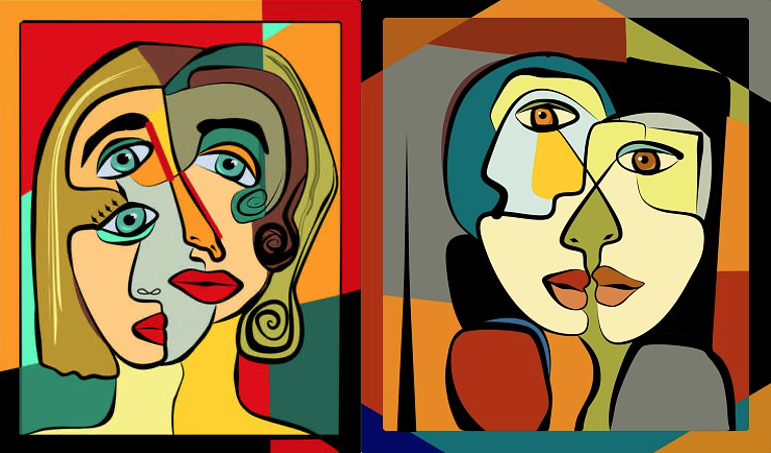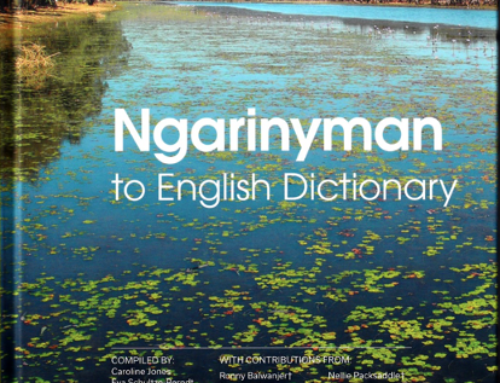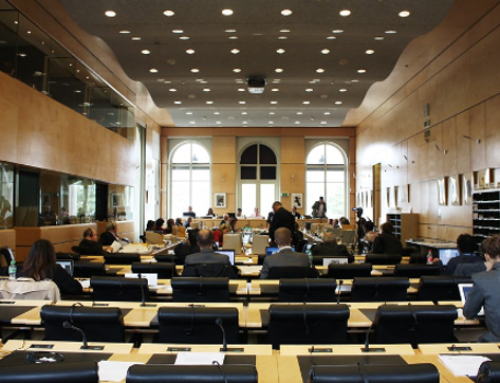On September 6, 1898, Cambridge-based anthropologist Alfred C. Haddon was five months into his fieldwork on the Torres Straits archipelago. On that Tuesday, on Mer Island, he set up his London-made, hand-cranked 35mm N&G Kinematograph in a banana grove. He then requested three men to undress and wear skirts made from materials readily available in the grove. Haddon sourced cardboard from his packing materials, cut it in the shape of a turtle, and asked one of the men to wear it on the back of his head. This man would also wear a mask made of cardboard and other found materials. The three men lined up in single file, directly in front of the camera, swayed their bodies in a coordinated manner, took a few steps forward, did a 360 degree turn, and returned to the original position, twice, in 40 seconds.1 Haddon offered the men gold in exchange for their performance. They took Haddon’s gold, but passed it on to Christian missionaries.
The choreography and costumes were a reenactment of what had once been part of a multi-day male initiation ceremony. The ritual itself had not been practiced in 25 years and its material culture had been destroyed by missionaries. The props used in the film – the turtle shell, skirts, mask, etc. – are drawn from the Malu-Bomai saga, which describes the origins of the island’s eight clans. Haddon had developed an interest in the Malu-Bomai saga and attempted to film iterations of the story. Back in Cambridge, Haddon would screen this material to colleagues, accompanied by sound recordings from the field, and a lecture describing the theoretical and mythological context of the performance (see Henley 2013).
Practices of Anonymity in Anthropological Cinema
A 21st century audience may find Haddon’s approach to ethnographic cinema to display a lack concern for power relationships, the objectification of people, scopophilia, and staging. However, I would suggest that elements of Haddon’s ethical dilemmas continue to resonate today. There are questions regarding how to contextualize cinema in a field that is dominated by text, and how to deal with inter-personal relationships in the film-making process. What cinematic language is appropriate for conveying anthropological knowledge? Are the ethical standards applicable to Haddon’s writing the same for his film-making?
As it regards practices of anonymity and the use of pseudonyms in ethnographic film-making, my argument is that these practices are not innocent exercises. The decision to use pseudonyms has a direct relation on the project’s point-of-view and the film’s tone. In Haddon’s case, for example, his film is a reenactment of a myth, as he understood it. The islanders’ understanding of the myth, the myth’s place in people’s lives, its history, are of no bearing to the theory on myth that is being addressed in this project. The film emphasizes bodies in space, anonymous humans, performing actions which are contextualized in relation to a preexisting anthropological concern. Ultimately, the decision to not include personal identifiable information about the film’s participants is not as much a reflexive decision as the result of the project’s design and Haddon’s vision of anthropology.
Aspects of Haddon’s approach continued to be referenced throughout the 20th century. Margaret Mead’s 1952 film, Childhood Rivalry in Bali and New Guinea, also presents itself as an illustrated lecture where the images function as a device to facilitate an anthropological discussion. As the title suggests, the film describes patterns of inter-personal behavior in Balinese culture. It is structured as a series of vignettes that document specific situations. Stylistically, Mead favors the long take, shot from a privileged point of view, on a tripod, without intruding in the action. The soundtrack is Mead’s voice-over describing the vignettes and explaining their anthropological significance to the audience. She addresses the people filmed in the third person plural, a narrative device that frames her findings as if they were reproducible.2
The level of theoretical abstraction that Mead is interested in – i.e., behavioral patterns in specific cultures – does not require the personal identification of the film’s participants. This kind of research question, like Haddon’s, focuses on a discursive problem of anthropology (e.g. myth, cultural relativity). Cinema, in these instances, is approached as a research instrument that provides evidence for an anthropological concern. As a device that is expected to document events for future analysis, the process of analyzing the footage is largely separated from its production. What follows is that the footage is assessed for its illustrative capacity, its potential to serve as evidence for an anthropological argument. In this scheme, the footage is data, which is then sequenced in accordance to a predetermined logocentric scheme.
Mead’s approach supposes an instrumentalization of film for anthropology in an analogous fashion to the microscope for biology or the telescope for astronomy: a tool that provides data in the service of the research project. In this context, the research subjects are treated as symbolic articulations of a social structure, their role in the film is to stand-in for the presumed “Indonesian mother,” “Indonesian child,” “father,” “aunt,” etc. The effect is an erasure of the individual’s voice in favor of a characterization of people in relation to the researcher’s agenda. The anonymity that is at stake here is of a conceptual and discursive kind, the result of a relationship of power. The question of anonymity, in this instance, is related to the process of authoring a point-of-view. The decision of what information to include and exclude, what kind of information, and in what way it is presented is determined by the researcher’s vision and the quality of the relationship that the researcher maintains with informants.
A Shared Anthropology
On August 15, 1954, two years after the release of Mead’s Childhood Rivalry in Bali and New Guinea, Paris-based anthropologist Jean Rouch was invited by his long-term associates to film a hauka possession ceremony in the outskirts of Accra. Rouch brought along his Nigerien friends Damouré Zika and Lam Ibrahim Dia to record sound. The three men had met over a decade earlier and would continue to work together throughout their lives. Rouch filmed the event with his handheld Howell Film 70 camera, purchased in 1946 at a Paris flea market. The handheld camera allowed him to position himself at the center of the action, to move around the site, following the men as they performed their ritual. The recording of this event was a continuation of Rouch’s research on rural to urban migration in the Sahel, spirit possession, and the relationship between imagination and reality in the context of emerging modernity (Henley 2010).
On his return to Paris, Rouch assembled a rough cut of the footage and presented it to colleagues in the screening room of the Musée de l’Homme. During the ritual, the hauka members are entranced, and assume identities of colonial officials, such as the Governor, General, Major, Corporal of the Guard, and so on. The footage depicted extraordinary moments of physical self-harm, possessed individuals foaming at the mouth, animal sacrifice, and blood drinking. The feedback on the material was negative. Marcel Griaule, Rouch’s academic supervisor, proposed that Rouch destroy the footage (Henley 2010). The concern was that the material encouraged European racist prejudices against colonial Africans.
Rouch did not destroy the footage. He engaged feature film editor Suzanne Baron and they worked on the material to address the concerns raised at the museum screening. Baron and Rouch approached the film as a story, a filmed narrative, and contextualize the ritual as a response to European colonialism, West African urbanization, and the personal concerns of film’s participants. The film follows a three-part structure where (1) a sequence depicts a range of labor activities of migrants in Accra, (2) the characters travel to the ritual site and hold the ritual, and (3) the next day the characters are seen back at work in the city, in good physical and emotional health, smiling directly to the camera, the emotional distress experienced by the hauka members having been resolved.
This approach to film-making and story-telling places the experiences of the sect members at the center of the narrative. The film-makers make it clear that this footage was collected at the request of the hauka members and that Rouch improvised the shoot following their lead. The effect is a collaborative piece, where the production process is part of the ethnography. The camera is mobile, positioning itself at the center of the action, not at a reserved distance. The viewer is not presented with an objective rendering of an anthropological event. Rather, the audience is encouraged to engage emotionally and intellectually with the piece and are empowered to develop their own relationship with the characters.
The result is a film that does not judge the hauka according to Western standards, but makes a case for the empowering qualities of the ritual. The colonial world that is evoked in the ritual is absurd, authoritarian, and violent. Whatever ugliness or shock value is in the film can be seen as a description of colonialism from below, not a judgment of African culture. The film can be seen as an instance where the voices of the research participatns are prioritized, no matter how uncomfortable it is for the film-maker or the viewer. From this perspective, the idea that film subjects require anonymity is somewhat anachronistic to Rouch’s overall research program. If anything, anonymizing could be seen by Rouch’s informants as a betrayal of the trust they invested in him when they invited him to film their ceremony.
The film was released in 1955 with the title Les Maîtres Fous (The Mad Masters), suggesting perhaps the madness associated with European colonial authorities. The film brought Rouch international recognition. For Marc Piault, Les Maîtres Fous is a “truly foundational film, without doubt one of the cult films of both cinema and anthropology” (Piault 1997). Along with Rouch’s other films Moi, un Noir (1958), Chronicle of a Summer (1961), and Jaguar (1967), Les Maîtres Fous represents an early experiment in the highly influential film genre of ethnographic fiction.
The Ethics of Anonymity

Anonymity is not only about removing personal identifiable information of the people with whom we work. The question of how much or how little information to reveal and how to contextualize it informs the ethnography’s tone, its scope, and the perspective to be highlighted. The ethics of anonymity are linked to broader issues of politics of representation, voice, and the relationships of power during the research process. A recurrent theme in the institutional discussions on the ethics of anonymity emphasize a binary opposition between the interests of the research subject and the researcher’s – wherein it is assumed that the researcher’s work endangers people. For Kohn and Shore, ethics committees in a neoliberal university context are more focused on protecting the university from legal liability and protecting the university’s reputation, than ensuring the ethical conduct of researchers or the well-being of the participants (Kohn and Shore 2017). Anonymity in an ethnographic film, for example, may suggest that the footage was collected or is being presented without the subjects’ informed consent. Anonymity can also be used strategically by the anthropologist who seeks protection from informants who would take offense at the work and, possibly, seek redress from the researcher and their university.
From a Rouchian perspective, ethnographic film-making is based on the development of relationships of deep trust between the film-maker and the subjects. Rouch actively collaborated with his research subjects, in some cases over decades. His works address intimate subjects like racism, sex, and imperialism through inter-subjective, dialogic perspectives, rather than as a response to debates circulating in academic literature. Rouch’s approach also acknowledges the role he plays in contributing to the ethnographic event, which he then records. In Les Maîtres Fous, for example, the ritual was performed so that Rouch would record it. In Chronicle of a Summer (1961), Rouch’s most famous film, he makes it clear that the performances we see on the screen are mediated and provoked by the film-making process. A further layer of complexity is added towards the end of the film, when the subjects are seen watching the film we have just seen, and they comment on their performances. It is an approach to ethnography that reflects on itself, a shared anthropology where the anthropologist engages in a dialogue with the subjects’ faces, voices, and perspectives. It is an anthropology where the informants also have a stake in the work. In these instances, the notion that the research will work against the interest of the informants is significantly less tenable.
The argument is a case for understanding anthropological film-making as an active engagement with the world, the experience of which has transformative effects on the film-maker, the subjects, and the audience. The ethics at stake are the result of relationships that are developed in the course of the research, rather than dictated in advance by committee. Rouch’s practices oppose the expectation that the researcher can be extracted from the production process. It also rejects the view that the researcher can be relieved of the responsibility of the politics of representation through the signing of a release form. The vision for a shared anthropology imagines transcending the binary opposition between academia and the world:
Finally then, the observer has left the ivory tower – his camera, tape recorder, and projector have driven him, by a strange road of initiation, to the heart of knowledge itself. And for the first time, the work is not judged by a thesis committee but by the very people the anthropologist went out to observe (Rouch 1974, 43).
My argument is also for taking the film-making process seriously and acknowledging that film communicates different kind of knowledge, and in a different way, than text. For example, the films that I have been referencing here were made from footage that was produced in the course of participant observation. This kind of footage emphasizes presence, bodies in space, a sense of duration and progression. In the cases of Haddon and Mead, the footage is contextualized in relation to a pre-existing logocentric anthropological discourse. This results in a piece that is meant to reproduce, instantiate, or illustrate an abstract theoretical model. The effect is a film that studies a concept that has no visual register – i.e. concepts like culture, power, gender, kinship do not exist in the material world and cannot be photographed, they are inferred from experience and described with words. Rouch’s approach, on the other hand, is more akin to conducting research with a camera. Where the camera is not taken as a research instrument, but as a technology that frames experience in peculiar ways.
A cinematic approach to fieldwork requires an understanding of how cinema works, its capabilities, limitations, and story-telling devices. Rouch, for example, referenced cinematic techniques like montage and collaborations in the process of framing his fieldwork experiences. For filmmaker David MacDougall, the development of a genuine visual anthropology lies more in the production of films that reference anthropological concerns, rather than produce films about preexisting anthropological theories (MacDougall 2005). In other words, to begin with cinema, as a practice, in the service of producing new anthropological approaches, rather than to begin with anthropology and retroactively attach images and sounds to it.
I would suggest that the idea of erasing, sanitizing, or hiding people’s voices, intentions, and identities in ethnographic film-making is in tension with anthropologists’ claim that ethnographic knowledge is generated in an immersive relationship with people and that the goal is to understand perspectives that are not our own. We work with people and we owe it to them to make good on their perspective. Anonymizing people carries with it the potential to erase or minimize the relevance of their worldviews. It runs the danger of placing the anthropologist/writer at the center of the narrative and promoting their views at the expense of the informants who have been so generous with their time.
Notes:
[1] https://www.youtube.com/watch?v=XuVDciKvJ0Q&list=PL6612EBC92A034FEF&index=6&t=1s
[2] https://www.youtube.com/watch?v=4NqQ6KL-aUY&list=PL6612EBC92A034FEF&index=3&t=312s
References
Henley, Paul. 2013. “Thick Inscription and the Unwitting Witness: Reading the Films of Alfred Haddon and Baldwin Spencer.” Visual Anthropology 26(5): 383-429.
Henley, Paul. 2010. The Adventure of the Real: Jean Rouch and the Craft of Ethnographic Cinema. Chicago: University of Chicago Press.
Kohn, Tamara, and Cris Shore. 2017. “The Ethics of University Ethics Committees: Risk Management and the Research Imagination.” In Death of the Public University?: Uncertain Futures for Higher Education in the Knowledge Economy, edited by Susan Wright and Cris Shore, 229 – 249. New York: Berghahn.
MacDougall, David. 2005. The Corporeal Image: Film, Ethnography, and the Senses. Princeton: Princeton University Press.
Piault, Marc-Henri. 1997. “Preface: Regards Croisés, Regards Partagés.” In Les Hommes et les Dieux du Fleuve: Essai Ethnographique sur les Populations Songhay du Moyen Niger, 1941– 1983, edited by Jean Rouch, 7-20. Paris: Éditions Artcom.
Rouch, Jean. 1974. “The Camera and Man.” Steve Feld, trans. Studies in the Anthropology of Visual Communication 1(1): 37-44.
Cite as: Cubero, Carlo A. 2021. “What Does Anonymity Mean in Ethnographic Filmmaking?” In “Rethinking Pseudonyms in Ethnography,” edited by Carole McGranahan and Erica Weiss, American Ethnologist website, 13 December 2021, https://americanethnologist.org/features/collections/rethinking-pseudonyms-in-ethnography/what-does-anonymity-mean-in-anthropological-filmmaking
Carlo A. Cubero is Associate Professor of Social Anthropology at Tallinn University, where he lectures on visual anthropology and cosmopolitan anthropology.




